Wilburn “Bill” Williford: Veteran of the Month | May 2024
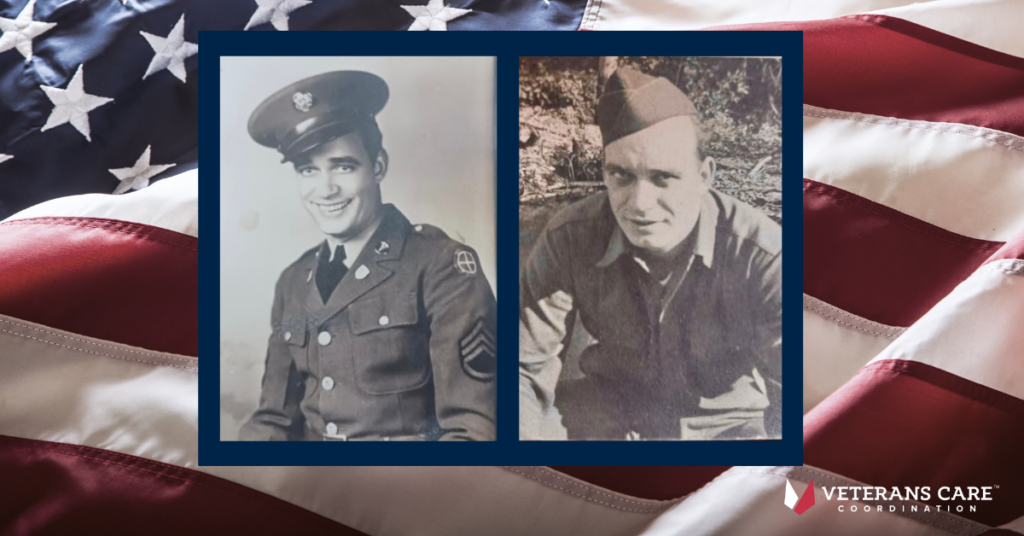 Wilburn “Bill” Williford was the oldest child among seven siblings. He was born in Whitten, Arkansas, in 1917, but his family later moved to the Bootheel of Missouri to search for better employment opportunities. His father worked various odd jobs to support the family, and when Williford was only 7 or 8 years old, he started picking cotton to help his family earn a living. As a young man, Williford loved sports, especially baseball and basketball. By the time he was in eighth grade, his family relocated to Saint Louis, still searching for better employment opportunities.
Wilburn “Bill” Williford was the oldest child among seven siblings. He was born in Whitten, Arkansas, in 1917, but his family later moved to the Bootheel of Missouri to search for better employment opportunities. His father worked various odd jobs to support the family, and when Williford was only 7 or 8 years old, he started picking cotton to help his family earn a living. As a young man, Williford loved sports, especially baseball and basketball. By the time he was in eighth grade, his family relocated to Saint Louis, still searching for better employment opportunities.
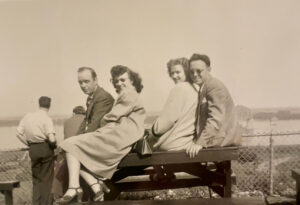
From left: Bill Williford, Marge Williford, Rose Hager (Marges sister), Joe Hager in 1946.
Williford completed his schooling at Central High School in St. Louis and graduated at 17. He played on the basketball team throughout high school and graduated in 1933 during the Great Depression. Williford struggled to find work due to the state of the economy but managed to find odd jobs in welding and electric fields for a few years. In order to improve his situation, he decided to enlist in the National Guard in April 1940. While he was in the National Guard, he was sent to Alaska for several months because the government was worried that our enemies would cross the Bering Strait and invade.
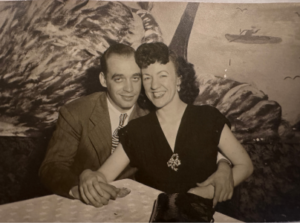
Marge and Bill Williford on their wedding day, January 14, 1947.
In December 1940, he was called to Active Duty by the United States Army. After performing exceptionally well on an IQ test, he was given the Military Occupation Specialty (MOS) of Medic or Medical NCO and was ranked as a Technical Sergeant. During WWII, medics were given the option to be armed, and if unarmed, it was considered a war crime to attack. The Red Cross symbol on their armbands and helmets was the only way to identify a medic during battle. Sadly, despite being a war crime, there were instances where unarmed medics were shot during the war.
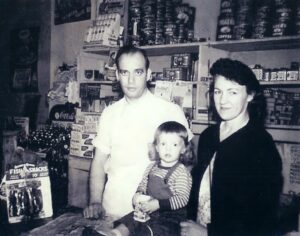
Bill and Marge Williford with their oldest daughter at their grocery store in St. Louis, MO, 1949.
Williford was a private and proud man who rarely discussed his service during the war. Although he seldom talked about his experiences, he did share a few stories with his family over the years. According to his oldest daughter, Carol, Williford chose not to carry a gun during the war as he did not believe in them. She further stated that her father witnessed some terrible things during the war, which were too graphic to talk about with his family. However, he did confide that there were too many instances where he would come across soldiers on the battlefield who were in excruciating pain, and all he could do for them was provide them with morphine. Carol stated, “We know he was there on D-Day and landed on one of the beaches but would never speak of which one or what happened.” She continued, “The rest of his life, he suffered from PTSD, and he disliked any loud noises, especially from loud aircraft.”
It wasn’t until his passing that his family discovered in his military paperwork that he was awarded Bronze Stars for his participation in three campaigns: Northern France, Rhineland, and Central Europe. It is stated that Williford valiantly ran out into battle, dodging bullets and carrying wounded soldiers back to safety.
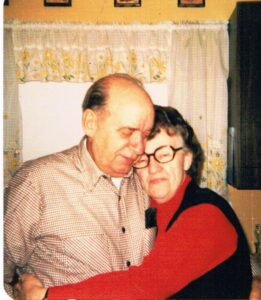
Marge and Bill Williford in their kitchen in the early 80s
Williford had a tough time returning home after the war ended in 1945. He spent several months on a ship and expressed to his family that he felt he was being treated like cattle. The ship was overcrowded, and they had to cram themselves into its hull for the long trip home.
Williford served his country for five years and ten days and was honorably discharged in October 1945. Upon returning to St. Louis, he started a grocery store with his brother-in-law at Hodiamont Tracks and Kingshighway, near the Suburban Street Car Tracks. While working as a butcher at the store, he met Margaret Branson, one of his customers, and asked her out on a date. Williford, who still loved baseball, took Margaret to see the St. Louis Browns play at Sportsman Park. New to baseball, Margaret asked him which team the umpires played on.
After a year of dating, they were married in a simple courthouse ceremony. Their first daughter, Carol, was born in October 1947. Williford later bought out his brother-in-law, and he and his wife ran the grocery store while living in an apartment above it until 1951. They then sold the store and moved to the suburbs, where Williford began working as an iron worker.
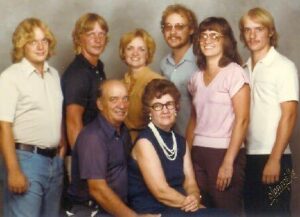
Williford family 1980.
The young couple went on to have a second daughter, Marilyn, followed by four boys, Tom, Jim, Bob, and John. They moved to Berkeley, MO, in 1951 where Margaret was a homemaker. The ever-private Williford, who never drew attention to himself or boasted in any way, actually helped build The Gateway Arch and never spoke much about it. His children only learned about his contribution to the St. Louis monument from his sisters.
After 27 years in Berkeley, the Willifords moved to St. Charles County in 1978. By 1980, Williford had retired from his career as an ironworker and loved spending time at the river with his family, which had grown to include sixteen grandchildren. He was always sharp as a tack and would amaze his grandchildren with how quickly he could unscramble their Rubix cube.
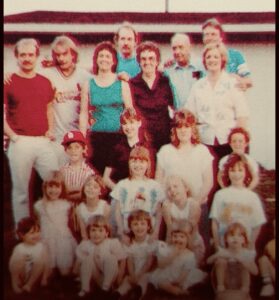
Williford family gathering Easter 1986.
In December 1986, Williford was diagnosed with the lung disease Idiopathic Pulmonary Interstitial Fibrosis. He passed away on July 18th, 1987, at 69 years of age. Despite the challenges he faced, Williford was dedicated and worked hard throughout life to provide for his family and serve his country with distinction. Today, his legacy lives on through his family, which now includes an impressive 35 great-grandchildren.
Veterans Care Coordination is proud to recognize Bill Williford for his service to our country. We are privileged to have the opportunity to share the stories of our nation’s heroes. Thank you for your service, Bill.
